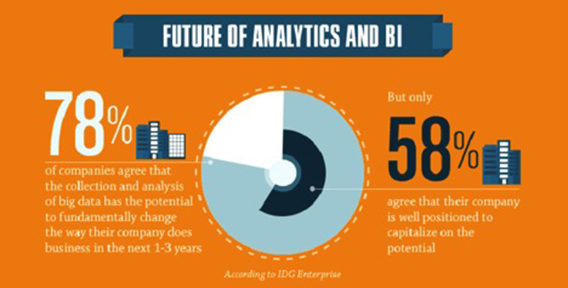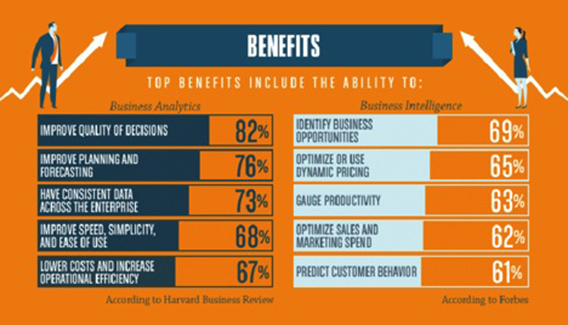Big Data is making an enormous impact on business growth and productivity, with companies reporting that methods of data collection and analysis can fundamentally change the way they conduct their business. Here, the key benefits of big data analytics and business intelligence are examined in the framework of the modern, data driven approach to business (infographic).

Click image to enlarge. Or visit the website.
With an influx of data being obtained by businesses, they have to determine the best ways to analyse it. They use several techniques, including analytics and business intelligence, which help companies make future decisions. Although business analytics and intelligence both help companies decipher big data, they each have unique processes and qualities.

Business analytics stimulate scenarios to predict future conditions and help companies find patterns after analysing previous and current data. The analytics technique is very technical and professionals use data mining, descriptive modelling and simulations to find upcoming trends. Business intelligence professionals use different types of software to analyse raw data which help them identify existing problems and contribute to current decision making. They can discover why something happened, how many times it happened and when all the events took place.
Companies are investing in data driven initiatives, because they can help them improve their customer relationships, make the business more data-focused and change the way operations are organised. Businesses use sales and financial transactions as the top source for their data initiatives. But only ten per cent of businesses consider themselves to be analytical innovators – meaning they have an analytic culture driven by senior mandate and have a sophisticated approach to prediction and prescription. The majority of organisations rate themselves as analytically challenged, because they suffer from data quality and access issues and they lack appropriate data management skills.
In fact, in a recent McKinsey Global Survey, the high performers say their analytical activities have had great impact on company revenue in the last three years. Some of the biggest differences between low and high performing companies are related to the leadership and organisation of analytic activities. High performer executives often rank senior management involvement as the factor that contributed to success, while low performers say their biggest challenge is finding the right organisation structure to support analytics.
Benefits of big data analytics

There are many benefits available to companies to become more involved with business analytics and intelligence.
The top benefits for business analytics are the ability to boost the quality of making decisions, improve planning and forecasting, have consistent data across the company and lower costs as well as increase operational efficiency.
Business intelligence’s best qualities are the ability to identify opportunities, gauge productivity, optimise sales and predict customer behaviour. Because of the overwhelming benefits, 78 per cent of companies agree collection and analysis of big data will fundamentally change the way they do business in the next three years, but only 58 per cent agree that their company is well positioned to take advantage of the potential.
Executives at high performing companies say they have better talent practices and more active CEO involvement – and that differentiates them from other companies. They also report that they have significantly more advanced data analytic capabilities. For example, they are five times more likely to have the tools and expertise to work with unstructured real-time data and are twice as likely to make data accessible across their entire organisation. High performers are more diligent when tracking results, with 54 per cent saying they track the impact of their analytic activities on top-line revenues, but only 19 per cent of low performers are doing the same.
Despite the push to use big data, the US is likely to face a shortage of qualified professionals. By 2018, there will be between 140,000 and 190,000 data scientist positions available as well as 1.5 million analyst positions. Most companies, especially low performers, indicated in the survey that they have trouble attracting and retaining talent in data and analytics – more so than in any other parts of their business – because of the lack of support from their leadership. The most significant talent shortages are due to a lack of structured career paths, especially in larger companies, and the inability to compete effectively on salary and benefits. With 77% of companies, these two challenges are even more difficult for companies where analytics’ work is decentralised, i.e. where employees work in individual units and act independently.
There are several ways to help low performing companies achieve a more data driven approach to decision making. Communication from the top is important in helping everyone understand the initiatives and vision for the organisation. Senior leaders need to work with team members to understand the importance of implementing the analytic procedures. Analytic organisation is also important for creating the greatest impact of the information. Although there is some debate over which model is best, the company needs to have the right balance of technical and domain expertise as well as making sure analytical resources are closely aligned with the goals and targets of the departments they represent.
Data driven reports can help companies make better decisions for the future of their companies and achieve their objectives. According to Forbes, companies that use business analytics and intelligence are five times more likely to make faster-than-average decisions that help them react quicker than their competitors. Companies need their leadership to implement and run data programs and find viable solutions to the talent shortage in order to make the information beneficial and help them succeed in future endeavours.
Have an opinion on this article? Please join in the discussion: the GMA is a community of data driven marketers and YOUR opinion counts.
Read also:
How focus on 5 key objectives based on business outcomes will deliver a robust RACI data management model
Report: agencies using DMPs to serve clients, win new business








Leave your thoughts